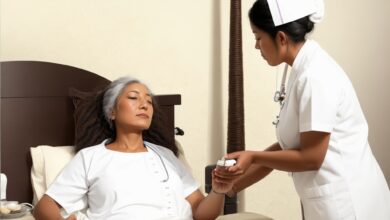Empowering Health Literacy Through Nursing: Bridging the Gap Between Medical Jargon and Patient Understanding

Introduction: The Power of Understanding
Imagine finding yourself in the middle of a foreign city without a map, desperately trying to find your way. This disorientation is precisely what many patients experience in the vast maze of healthcare without proper health literacy. At the heart of this knowledge transfer? Nurses! Let’s dive deep into the world of health literacy and unravel how nursing education has become the compass, guiding patients through their health journeys.
Unraveling the Enigma: What is Health Literacy?
Think of health literacy as the bridge between medical jargon and a layman’s understanding. It’s not just about reading prescriptions or medical bills but involves:
- Deciphering medical instructions.
- Making critical health decisions.
- Smoothly navigating the intricate web of healthcare systems.
Here’s a curveball: a significant number of people still struggle to understand their own health. A myriad of factors, like education level, cultural background, and language barriers, play a role in this. But the burning question is, how does this gap in understanding influence their health?
The Domino Effect: When Health Literacy Falters
It’s like a line of dominoes; one small misunderstanding can lead to a series of unintended consequences. The stakes? They’re pretty high:
- Imagine forgetting half of your medication dosage.
- Or landing up in the hospital more often than you’d like.
- It could even mean shelling out more bucks than necessary on healthcare.
Here’s a story that might pull at your heartstrings: [Introduce a fictional anecdote about a patient, “Jane”, who misunderstood her medication and faced severe health repercussions.]
A Beacon of Hope: Nursing Education
In the dark tunnel of healthcare complexities, nursing education emerges as a beacon of hope. It’s fascinating how nursing practices have evolved to focus more on patient education.
So, how exactly do nurses empower patients?
- Breaking it down: Nurses use plain, everyday language, replacing medical mumbo-jumbo.
- Show and tell: Visual aids come into play.
- Factoring in cultural nuances ensures everyone’s on the same page.
- And the golden rule? Always ensuring the patient can teach back what they’ve learned.
In a nutshell? It’s about transforming patients from passive listeners to active participants in their health journey.
Bridging the Gap: Overcoming Health Literacy Barriers
It’s not always a walk in the park. There are hurdles—some tall, some small. But nurses? They’re equipped to jump, sometimes even pole-vault over them.
The walls they often encounter include:
- Cognitive challenges that make understanding trickier.
- The tricky terrain of language differences.
- Socioeconomic barriers that often play spoilsport.
- Cultural beliefs that sometimes muddy the waters.
But with patience, persistence, and a sprinkle of creativity, these walls turn into mere speed bumps. And before you know it, they’re in the rearview mirror!
Real Stories, Real Impact: Nursing Education Success Tales
Picture this: [Introduce a second fictional anecdote about “Alex”, a patient who, with the help of a nurse, transformed his understanding of his health condition and made a remarkable recovery.]
These stories aren’t rare gems; they happen every day, echoing the monumental difference nursing education can make.
Blending Tradition with Tech: The Future Beckons
With the digital age in full swing, even healthcare isn’t left untouched. Telehealth sessions, mobile apps, and online platforms are complementing traditional nursing methods. It’s the age-old wisdom of nursing combined with the swag of technology!
Looking Ahead: The Evolution of Health Literacy
With the world zipping past at breakneck speed, health literacy is more critical than ever. Nurses, with their evolving roles and tools, are more than just caregivers—they’re educators, advocates, and guides.
So, the next time you find yourself lost in the labyrinth of health info, remember there’s a nurse out there, ready to guide you through, ensuring you’re not just a spectator, but a key player in your health journey.
The Unsung Heroes: Nurses on the Frontlines of Health Literacy
Ever thought about why nurses often spend more time with patients than doctors? It’s not just about administering medication or checking vitals. It’s about creating a connection, a bond that fosters understanding and trust. This bond becomes the linchpin in bridging the health literacy gap.
Let’s get down to the nitty-gritty:
- Personalized Education: Not every patient is the same. Nurses recognize this and tailor their approach accordingly. Whether it’s breaking down complex terminology for a teenager or using story-telling techniques for an elderly patient, nurses are often at their creative best.
- Feedback Loop: It’s not just a one-way street. Nurses encourage patients to voice their concerns, ask questions, and even clarify doubts. It’s this feedback loop that ensures that the message hasn’t just been delivered, but also understood and internalized.
Global Spotlight: Health Literacy Across the World
It’s tempting to think of health literacy as a concern unique to one’s region, but guess what? It’s a global challenge. From the bustling cities of Tokyo to the serene villages of Tuscany, health literacy is a topic under the microscope.
- Eastern vs. Western Approaches: While Western countries might leverage technology, the East often blends tradition with education. Think of holistic wellness teachings in India or herbal medicine knowledge in China.
- Cultural Sensitivities: Nurses across the globe are trained to respect and incorporate cultural beliefs into health education. In Muslim-majority countries, for instance, health teachings might revolve around fasting periods like Ramadan. In regions with indigenous populations, ancient and traditional healing practices are often integrated into modern healthcare teachings.
The Road Ahead: Challenges & Opportunities in Enhancing Health Literacy
Alright, let’s not sugarcoat it. There’s a long road ahead. With evolving diseases, newer medications, and ever-changing health guidelines, the task isn’t getting simpler. But here’s the silver lining: With challenges come opportunities.
- Integrating Technology: The rise of wearable health devices, health tracking apps, and online forums presents a unique opportunity. Nurses can recommend reliable apps or wearables to keep patients engaged and informed.
- Continuing Nurse Education: As the medical field evolves, so does the need for continuous learning. Workshops, courses, and seminars are crucial for nurses to stay on top of the latest in healthcare, ensuring they pass on accurate, updated information to patients.
Concluding Thoughts: The Symphony of Health Literacy
If healthcare were a symphony, doctors, surgeons, and specialists would be the various instrumentalists. But nurses? They’re the conductors, ensuring every section comes together in harmony, creating a melody of understanding and well-being.
So, the next time you’re at a clinic or hospital, and you spot a nurse explaining, teaching, or even drawing out a concept for a patient, take a moment. Recognize the profound impact of that simple act. And maybe, just maybe, join in the chorus of appreciation for these unsung heroes of health literacy.




